EXTERNAL TRADE PERFORMANCE
January 2010
(Preliminary)
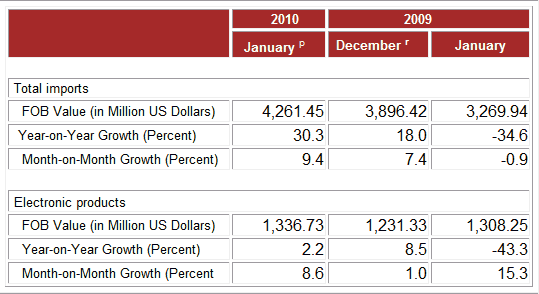
p - preliminary
r - revised
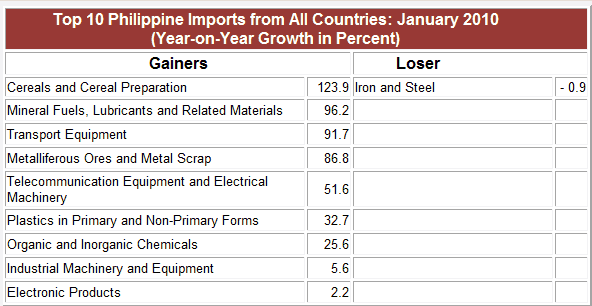
JANUARY 2010 TOTAL TRADE STANDS AT $7.841 BILLION
Total external trade in goods for January 2010 reached $7.841 billion, representing a 35.6 percent increase from $5.781 billion recorded during the same month in 2009. This was due to the 30.3 percent upward trend of total imports to $4.261 billion from $3.270 billion in January 2009. The same was true for exports where a 42.5 percent increment was observed to $3.579 billion from $2.511 billion in January 2009. Thus, the balance of trade in goods (BOT-G) for the Philippines in January 2010 registered a lower deficit of $682.00 million from $759.00 million deficit in same period last year.
Figure 1B Philippine Trade Performance: January 2009 and 2010
(F.O.B. Value in Million US Dollars)
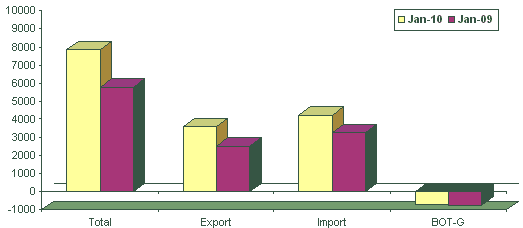
JANUARY 2010 IMPORTS UP BY 30.3 PERCENT
The country's total merchandise imports for January 2010 rose by 30.3 percent to $4.261 billion from $3.270 billion in January 2009. Compared to previous month's level, it increased by 9.4 percent from $3.896 billion.
ELECTRONIC PRODUCTS ACCOUNT FOR 31.4 PERCENT OF IMPORT BILL
Accounting for 31.4 percent of the aggregate import bill, payments for Electronic Products (including consigned and direct importation using the expanded coverage of electronic products) in January 2010 amounted to $1.337 billion. It went up by 2.2 percent over last year's figure of $1.308 billion. On a monthly basis, it grew by 8.6 percent from $1.231 billion recorded in December 2009. Among the major groups of electronic products, Components/Devices (Semiconductors) having the biggest share of 23.0 percent, decelerated by 6.5 percent from $1.049 billion to $980.81 million.
Imports of Mineral Fuels, Lubricants and Related Materials in January 2010 ranked second with 19.4 percent share and posted a positive growth of 96.2 percent to $827.92 million over the previous year's level of $421.93 million.
Transport Equipment, was the RP's third top import for the month with 8.9 percent share to total imports valued at $380.22 million. The report was up by 91.7 percent from previous year level of $198.34 million.
Cereals and Cereals Preparation, contributing 4.2 percent to the total import bill, was the RP's fourth top import for the month with payments placed at $180.69 million from last year's $80.72 million. It accelerated by 123.9 percent, the highest increase among the top ten imports.
Fifth in rank and with 4.1 percent share to the total imports, Industrial Machinery and Equipment recorded $174.51 million worth of imports, higher by 5.6 percent from its year ago level of $165.33 million.
Organic and Inorganic Chemicals ranked sixth, comprising 2.4 percent of the total imports registered $101.61 million worth of imports, rose by 25.6 percent from its year ago level of $80.92 million.
Rounding up the list of the top ten imports for January 2010 were Plastics in Primary and Non-Primary Forms accounting for $86.54 million; Iron and Steel amounting to $83.57 million; Telecommunication Equipment and Electrical Machinery, $76.25 million; and Metalliferous Ores and Metal Scrap, $70.80 million.
Aggregate payment for the country's top ten imports for January 2010 reached $3.319 billion or 77.9 percent of the total import bill.
Figure 2 Philippine Top Six Imports: January 2009 and 2010
(F.O.B. Value in Million US Dollars)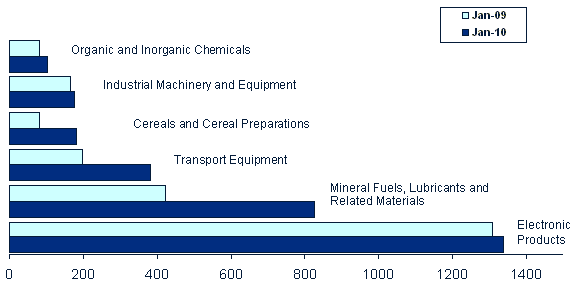
RAW MATERIALS AND INTERMEDIATE GOODS ACCOUNT FOR 34.0 PERCENT OF THE TOTAL IMPORTS
Accounting for 34.0 percent of the total imports, payments in January 2010 for Raw Materials and Intermediate Goods amounted to $1.448 billion or 8.4 percent decline over last year's figure of $1.582 billion. Compared to the previous month's level, purchases went up by 6.0 percent from $1.367 billion. Semi-Processed Raw Materials had the biggest share of 30.5 percent and valued at $1.299 billion.
Capital Goods, which comprised 32.5 percent of the total imports, went up by 51.4 percent year-on-year to $1.383 billion from $913.89 million.
Mineral Fuels, Lubricants and Related Materials with 19.4 percent share, increased by 96.2 percent to $827.92 million from $421.94 million in January 2009.
Purchases of Consumer Goods amounted to $545.30 million or an increase of 70.6 percent from $319.57 million in January 2009, while Special Transactions went up by 71.9 percent to $56.72 million from $33.00 million in January 2009.
Figure 3 Philippine Imports by Major Type of Goods: January 2009 and 2010
(F.O.B. Value in Million US Dollars)
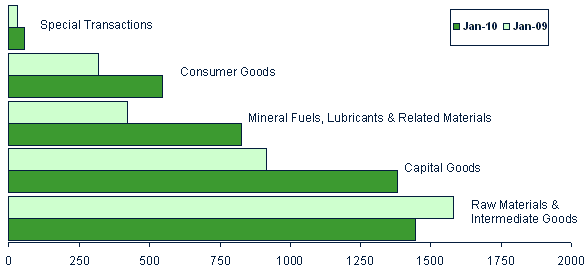
IMPORTS FROM THE UNITED STATES OF AMERICA ACCOUNTS FOR 13.4 PERCENT
United States of America (USA) including Alaska and Hawaii, was the country's biggest source of imports for January 2010 with 13.4 percent share of the total import bill, lower by 1.4 percent from $578.82 million in January 2009 to $570.72 million. Exports to USA amounted to $574.83 million, yielding a two-way trade value of $1.146 billion and a trade surplus for RP of $4.11 million.
Singapore, the second biggest source of imports with 12.7 percent share, recorded payments worth $540.01 million, an increase of 60.6 percent from $336.23 million in January 2009. Revenue from RP's exports to Singapore, on the other hand, reached $354.09 million, generating a total trade value of $894.11 million and $185.92 million trade deficit for the Philippines.
Japan including Okinawa, came third, accounting for 11.5 percent share of the total import bill in January 2010 with positive growth of 38.5 percent to $491.79 million from $354.99 million during the same month in 2009. Exports to Japan amounted to $579.98 million resulting to a total trade value of $1.072 billion and a trade surplus of $88.19 million.
People's Republic of China settled fourth; accounting for 8.6 percent share of the total import bill in January 2010 or an increase of 3.3 percent to $365.98 million from $354.35 million during the same month in 2009. Exports to People's Republic of China amounted to $296.69 million resulting to a total trade value of $662.66 million and a trade deficit of $69.29 million.
Fifth in rank is Taiwan, representing 7.3 percent of the total import bill in January 2010, amounted to $309.59 million. Meanwhile, export receipts from Taiwan in January 2010 reached $100.86 million yielding a total trade value of $410.45 million and a trade deficit of $208.73 million.
Other major sources of imports for the month of January 2010 were Republic of Korea, $294.53 million; Malaysia (including Sabah and Sarawak) $256.12 million; Thailand, $238.01 million; Saudi Arabia, $156.17 million; and Indonesia $149.65 million.
Payments for imports from the top ten sources for January 2010 amounted to $3.373 billion or 79.1 percent of the total.
Figure 4 Philippine Imports by Country: January 2010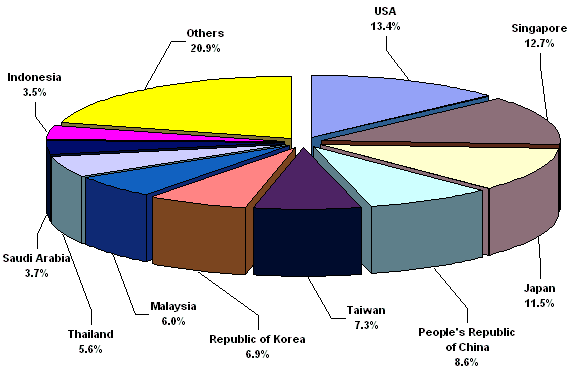
IMPORTS FROM EASTERN ASIA WORTH $1.600 BILLION
Philippines total imports in January 2010 with Eastern Asia (China, Hong Kong, Japan, Macau, Mongolia, North Korea, South Korea and Taiwan) accounted for 37.6 percent of the county's total imports with total payments of $1.600 billion or a positive annual growth of 24.2 percent from January 2009 level of $1.288 billion. Total exports to member-countries of Eastern Asia was valued at $1.404 billion, resulting to a total trade of $3.004 billion and a balance of trade in goods (BOT-G) deficit of $196.62 million.
Imports from ASEAN member-countries in January 2010 ($1.314 billion) contributed 30.8 percent share, higher by 74.0 percent from $755.09 million registered in January 2009. Exports to ASEAN member-countries worth $651.95 million resulted to a total trade of $1.966 billion and a trade deficit of $661.66 million.
January 2010 imports from European Union were valued at $277.90 million while exports to member-countries of European Union were worth $715.46 million. This aggregated to total trade of $993.35 million and a trade surplus of $437.56 million.
Figure 5 Philippine Imports by Selected Economic Bloc: January 2009 and 2010
(F.O.B. Value in Million US Dollars)
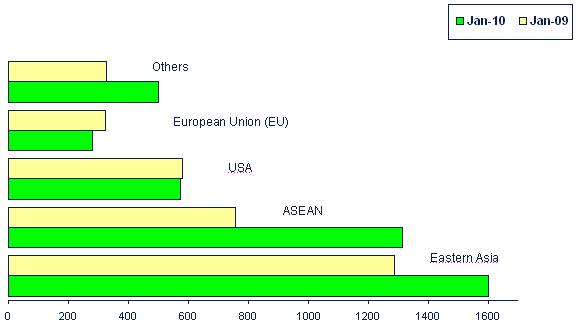
Technical Notes:
1. Adjustments on electronic import statistics are based on the transactions that pass through the Automated Cargo Operating System (ACOS) of the Bureau of Customs (BOC).
2. Starting with the January 2007 Press Release, analysis and tables are based on the 2004 Philippine Standard Commodity Classification (PSCC) groupings. This is in compliance with NSCB Resolution No. 03, Series of 2005 entitled "Approving and Adopting the 2004 Philippine Standard Commodity Classification" by all concerned government agencies and instrumentalities.
(Sgd.) CARMELITA N. ERICTA
Administrator
Source: Foreign Trade Statistics Section
Industry and Trade Statistics Department
National Statistics Office
Manila, Philippines
